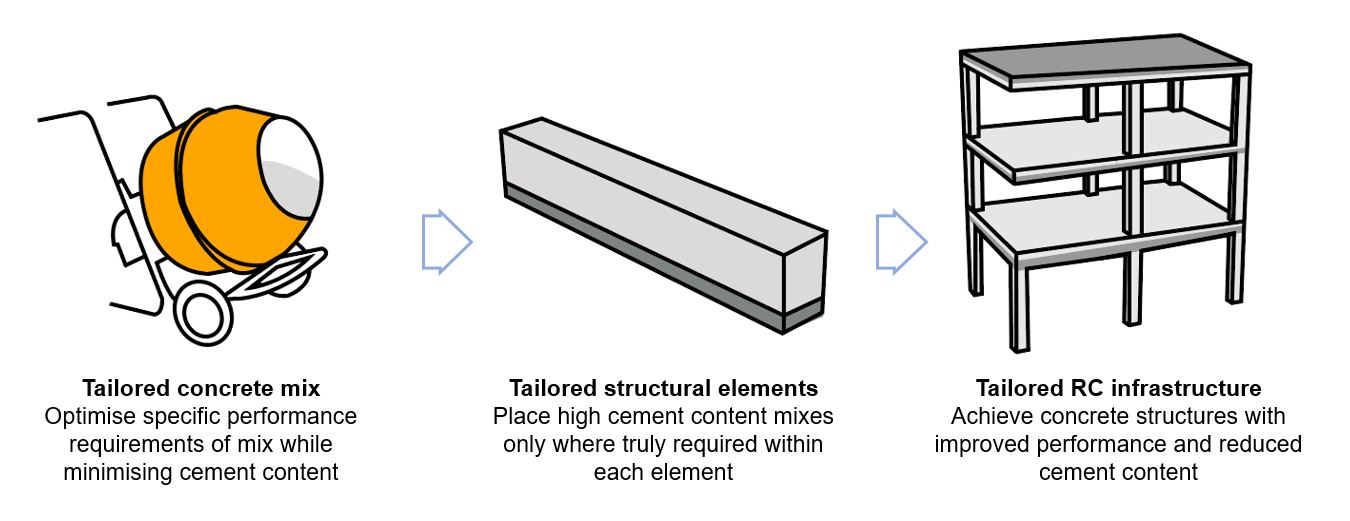Nishangani Gowrikanthan, Professor Janet Lees
Introduction
Concrete is the most widely used material in the world. Cement, the key constituent of concrete, is responsible for about 5% of global carbon emissions related to human activities. This makes the current use of concrete particularly hazardous for the environment. Hence, it is vital to develop technologies aimed at minimising the use of cement in concrete structures while preserving, or improving, their innate strength and durability properties.
In this context, the concept of tailored reinforced infrastructure represents a promising approach to target specific structural performance while employing less cement. The design of tailored, or functionally graded, concrete infrastructure is based on the idea of grading material composition through structural elements in order to achieve multiple objectives. In other words, material with high cement content is used rationally only when it contributes significantly to the overall performance of the structure. One major challenge in the design of tailored reinforced infrastructure is to understand the effects of geometry and main mix design parameters on strength and durability properties of the hardened structure. This entails a deep understanding of the complex relationships between design variables and specific structural properties as well as a comprehensive analysis of the trade-offs. A further concurrent challenge is to design geometry and concrete mixes in light of the desired fresh state behaviour of the structure. This encompasses an in-depth analysis of the relationships between geometry, rheological properties of the candidate mixes and fresh state stability of the system.

Aims and objectives
The fundamental aim of this research is to contribute to the reduction of carbon emissions by developing robust and reliable methods for the design, construction and assessment of tailored reinforced infrastructure. Specifically, the main objectives of the research are:
- To minimise the cement content of concrete while preserving its strength, durability and thermal mass properties at a material level.
- To optimise the design of tailored reinforced structures as structural elements by studying the interconnections between design parameters, fresh state behaviour and hardened state performance of functionally graded systems.
- To translate generated theoretical and technical advancements into real-life industrial applications in order to address engineering sustainability priorities for lifetime extension, lifetime costs reduction and energy minimisation.
Research projects
-
Fresh state behaviour of multi-mix elements
-
Structural properties of multi-mix elements
-
Interface properties of multi-mix elements
Collaborators
This project is funded by the UK Engineering and Physical Science Research Council (EPSRC). Industry collaborators on this work are Costain, Laing O'Rourke LTD and Skidmore, Owings & Merrill LLP.
Selected Publications
| Giménez Fernández, M. & Lees, J.M. (2025) Flexural behaviour of functionally graded reinforced concrete slabs with vertical or horizontal layers, Engineering Structures, v. 322, Pt A, 119046, https://doi.org/10.1016/j.engstruct.2024.119046 |
| Mak, M.W.T. & Lees, J.M. (2023) Carbon reduction and strength enhancement in functionally graded reinforced concrete beams. Engineering Structures, v. 277, https://doi.org/10.1016/j.engstruct.2022.115358 |
| Maier, M and Lees JM. (2022) Interlayer fracture behaviour of functionally layered concrete, Engineering Fracture Mechanics, 271, 108672. https://doi.org/10.1016/j.engfracmech.2022.108672 |
| Brault A, Lees JM. (2020) Wet casting of multiple mix horizontally layered concrete elements. Construction and Building Materials, 247, 118514. https://doi.org/10.1016/j.conbuildmat.2020.118514 |
|
Torelli G, Giménez Fernández M, Lees JM. (2020) Functionally graded concrete: Design objectives, production techniques and analysis methods for layered and continuously graded elements. Construction and Building Materials, 242, 118040. https://doi.org/10.1016/j.conbuildmat.2020.118040 |
| Torelli G, Lees JM. (2020) Interface bond strength of lightweight low-cement functionally layered elements. Construction and Building Materials, 249, 118614. https://doi.org/10.1016/j.conbuildmat.2020.118614 |
| Torelli G, Lees JM. (2019) Fresh state stability of vertical layers of concrete. Cement and Concrete Research, 120, 227-243. https://doi.org/10.1016/j.cemconres.2019.03.006 |

